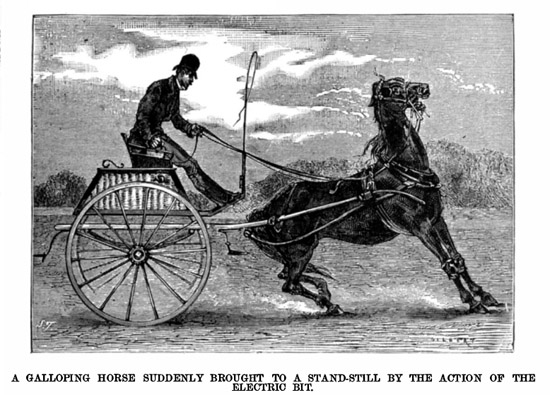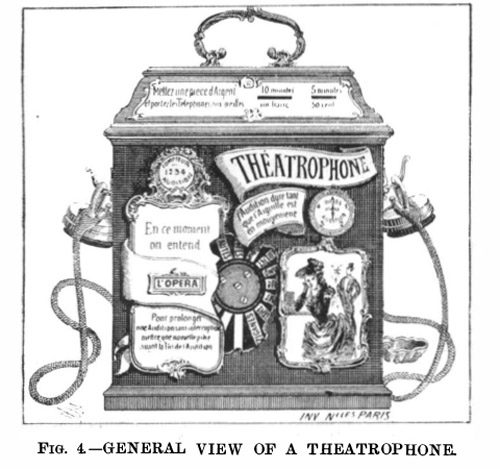
Jun 22, 2011 | 3
Since its discovery, electricity has helped humans make labor and tools more efficient. From lighting to toothbrushes, electricity has aided us in making our lives simpler and more convenient. However, while searching through the archives, I’ve come across some inventions that have led me to question whether we’ve taken advantage of technology in order to yield control.
Take for example the electric horse bit invented by M. Defoy and featured in the December 27, 1879, Scientific American Supplement. The bit was connected to an electromagnetic apparatus by metal wires placed in the reins. The rider simply turned the crank of the electromagnet and a current of electricity was sent to the horse’s mouth, meant to startle the creature into passivity.

The invention was deemed successful after being used on several “vicious” and “stubborn” horses who, when resisting being shod, were given the shock and immediately submitted. According to a report by the Superintendent of the Parisian Cab Company, M. Camille, “One horse that was to be shod went so far as to lie down and roll over and over on the ground, all the while struggling, defending himself, and fighting against everything; nothing could subdue him. I then had recourse to M. Defoy’s apparatus, and, on the first trial, much to my surprise, the feet of the intractable horse were lifted without any great difficulty, and on the second trial it was as easy to shoe him as if he had never made the least resistance; the animal was conquered.”
Jun 14, 2011 | 5
New York City is renowned for its great-tasting tap water, which is said to be amongst the purest in the country. However, when viewed under a microscope, the sight tends to disagree with the taste. Less than a year ago, it was reported that when looking at a microscopic droplet of this water, a NYC resident found tiny crustacean-like creatures floating around. The creatures—known as copepods—attack and eat mosquito larvae, helping to give the water its pure taste and are purportedly harmless to humans. While this may seem like a shocking discovery, Scientific American magazine had already reported on creepy crawling water dwellers in their October 10, 1846, issue.

Jun 8, 2011 | 1
Over the last few months, Syria has been making headlines almost daily as the struggles between the government and protesters have become increasingly violent. This past Friday, the city of Hama was the target of a government-led military assault that claimed the lives of at least 65 protesters and injured countless others. As tens of thousands of mourners gathered the next day, tanks began to surround the city and caused funeral processions to feel more like protests. The New York Times commented that the pattern of protest, crackdown, mourning, and protest is one that has been repeated hundreds of times in the Middle East in the past six months, beginning with the events in Tunisia.
The imagery of cyclical patterns of struggle and revolution were in the back of my mind when I came across the cover of the February 22, 1913, Scientific American. It featured the famed waterwheels of Hama, the same town so recently hit with violent government crackdowns.
May 31, 2011 | 3
While this chart may look like a series of exercises or dance moves, it actually depicts a system of numeration called “Homogenetic enumeration.”

It is similar to a semaphore flag system, except that instead of flags homogenetic enumeration uses only the limbs of the body to communicate numbers. According to the Scientific American article from July 9, 1892, it could be used as an alternative to Roman and Arabic numerals which because unlike these systems, it did not depend on written ciphers.
The left arm, used by itself, is moved into different positions to represent numbers 1-9. The right arm is used in the same manner but represents tens, while the left leg represents hundreds and the right leg thousands. “In order to represent any given number by means of these figures, it is first necessary to divide it into units, tens, hundreds, and thousands. Thus 1892 will not be represented as eighteen hundred and ninety-two, but as one thousand, right leg extended at right angles to body; eight hundred, left leg drawn up to an acute angle with the body and bent to an acute angle at the knee; ninety, right arm from shoulder at an acute angle to the body, right forearm horizontal; and two, left arm at an acute angle to the body.” The article suggests that to carry the series of numbers further, the signaler can stand on his head or wear hats of different patterns.
May 27, 2011
In 1915, it was imperative for France to keep its soldiers in good physical condition. The French War Ministry’s physical education school in Joinville looked for ways to improve soldiers’ performances and spot any problems with their health before they were sent to the Front. According to the cover story from the May 8, 1915 Scientific American Supplement, the school studied respiration, circulation, and muscular contraction with the aid of novel scientific research tools in their physiology lab. Professor G. Demeny invented several devices that helped determine the form and dimensions of the body while in motion and at rest. One of his most important contributions was an instrument called the “double universal conformator.”

The conformator may look a bit like a torture trap, but it was designed to measure the vertical and horizontal shape of the torso. The instrument consisted of metal rods with numerous thin strips of wood attached, each able to move on its own at a right angle to the rod. The wood strips moved to fit against the contours of the body, much like one of those pin impression toys that encourage one to stick a hand or face into a bed of pins in order to make a relief. The shape made by the body’s contour could be held in place by tightening a nut at the end of the rod, allowing an outline to be traced.
May 24, 2011 | 7
Gazelles have polygynous mating habits. Usually, males will mate with many different females throughout their lifetimes. Yet, this short article from the August 14, 1847, Scientific American suggests a monogamous bond between gazelle that was so strong it produced a tragic ending:

While the article suggests grief to be the culprit of the male gazelle’s suicide, it seems improbable unless their captive lifestyle led to a monogamous relationship. Perhaps the male gazelle also ate whatever made the female expire, and it caused some neurological damage, making him harmful to himself and others. It is certainly hard to deduce from the information in the article. We do know that the male gazelle suddenly sprang forward into a wall. Whether intentional or not, this action seems like the same one performed by gazelles when they are pursued by a predator, known as “stotting,” or jumping into the air with all four legs simultaneously off the ground. Here’s an example:
May 20, 2011
Between cds, mp3s, live streams, satellite radio, and even conventional AM/FM radio, it’s hard to imagine being without near-instantaneous access to music. While it may seem like only recently that we’ve been able to listen to music via our phones, it turns out people were doing just that over 100 years ago.
The July 2, 1892, Scientific American Supplement reported on the use of a device called the theatrophone that had been in use for two years already in Paris. The basic idea was to be able to call into a theater and hear live music being played. One could either subscribe to receive the service in home or utilize one of the theatrophones set up in various locales such as hotels, restaurants, vestibules, and cafes throughout the city.

For 50 centimes, one could listen to five minutes of music. A wicket on the front of the machine displayed the theater from which the music was heard. There was one central station where the Theatrophone Company operated out of, and this was connected to several secondary stations that were placed in the theaters. A series of microphones were set up on the stage and picked up the sound to be transmitted back to the central station.
May 18, 2011 | 5
By now, we are all familiar with the many reasons we need to lessen our dependency on oil and of the importance in looking for alternative and renewable energy sources.
If you need any more convincing, however, maybe you'll go along with an idea printed in the October 11, 1862, Scientific American.

Just three years before this article was published, one of the first successful oil wells had been drilled under the direction of Edwin Drake near Titusville, Pa., an area where oil seeps had been known to exist for many years.
Almost 150 years later, decisions of whether or not to drill on American soil are still being argued. Whereas the reasons may have changed (we no longer need to worry that using up our oil supply will cause the world to literally stop turning--although maybe figuratively), the need to find alternative energy sources is as clear as ever. I love that the unnamed gentleman is quite certain about his hypothesis, and that the article calls attention to the fact that the exhaustion of the oil supply would not be fixed by any amount of money.
May 13, 2011 | 8
Since today is Friday the 13th, I’d like to share with you an unlucky situation I came across in the Scientific American archive. When I first saw this photograph from the December 15, 1917, issue, I had a very hard time figuring out what I was looking at.

First, I thought it was a petrified human heart or maybe a rotten red pepper. Then, I finally recognized the head of a bird sticking out of whatever that rock-like mound was supposed to be. Of course, I could have just read the caption, “A sparrow stuck in a breakfast roll” and saved myself some guesswork.
The accompanying article states that birds tend to be voracious eaters, often taking in twice their body weight in order to fuel their very high energy levels. Rarely do you see scraps of bread on the ground that aren’t pecked at by a few birds, but this sparrow seemed to have more than pecking in mind.
May 10, 2011
If you’ve been near a garden lately, chances are your nose has picked up on the unmistakable scent of the roses in full-bloom in many places right now. The sight of the rose certainly holds a great amount of symbolic meaning in cultures throughout the world, though it can be argued that smell is even more important. According to an article on the "attar" or fragrant oils of the rose in the May 1921 Scientific American Supplement, “Supreme among the charms of the rose is its exquisite and haunting fragrance, a fragrance at once delicate and powerful…Small wonder that the ancients felt the perfume to be the soul of the rose…”

When the article was written, the majority of rose essence was made in the Balkans where the high amount of crumbled syenite made the soil very fertile. Both red roses (Rosa Damascena) and white roses (Rosa Alba) were planted, although the red’s fragrance was much stronger. If a garden were properly planted, it would yield about 100 pounds of flowers per day for 3 weeks. The flowers had to be gathered before the sun was too high in the sky, as the buds needed to remain unopened. Then, the flowers had to be taken to a nearby distillery as quickly as possible, as the oil’s fragrance is weakened after 24 hours.
Get weekly coverage delivered to your inbox.

YES! Send me a free issue of Scientific American with no obligation to continue the subscription. If I like it, I will be billed for the one-year subscription.
